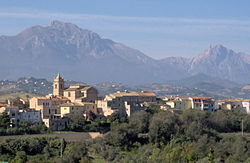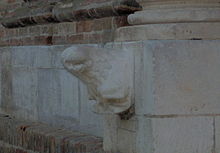Picciano
 From Wikipedia - Reading time: 7 min
From Wikipedia - Reading time: 7 min
This article needs additional citations for verification. (February 2024) |
Picciano | |
|---|---|
| Comune di Picciano | |
 View from the east | |
| Coordinates: 42°28′N 13°59′E / 42.467°N 13.983°E | |
| Country | Italy |
| Region | Abruzzo |
| Province | Pescara (PE) |
| Frazioni | Piccianello, Pagliari, Colletti, Le Piane, Incotte, Casette, Colli, Fontanelle. |
| Government | |
| • Mayor | Marino Marini |
| Area | |
• Total | 7 km2 (3 sq mi) |
| Elevation | 153 m (502 ft) |
| Population (December 31, 2006)[2] | |
• Total | 1,398 |
| • Density | 200/km2 (520/sq mi) |
| Demonym | Piccianesi |
| Time zone | UTC+1 (CET) |
| • Summer (DST) | UTC+2 (CEST) |
| Postal code | 65010 |
| Dialing code | 085 |
| Patron saint | San Vincenzo Ferreri |
| Saint day | 1st Sunday after Easter |
Picciano is a village and comune in Italy in the Province of Pescara, within the Abruzzo region. Its population at the end of 2006 was 1,398.
History
[edit]Picciano is first mentioned in 1049 when Bernardo Earl of Penne, with the Charta Offersionis, gave fields and buildings to build a Benedictine abbey in its hills. This is the first indication of the existence of a town called Picciano. and could be considered its terminus ante quem.
Many legends are known about the origin of the name "Picciano", the most believable talks about shepherds devoted to the Goddess Pithia; other variants of the name, found in the Charta Convenientiae, is "Piczano" so that perhaps the name of the town can be dated back to the Early Middle Age, avoiding conjectures about Roman origins.


Images
[edit]-
The campanile of Santa Maria del Soccorso from north
-
Picciano, Historic Centre
-
Picciano & La Bella Addormentata
-
Picciano e Piccianello
-
Piccianello from south
References
[edit]- ^ "Superficie di Comuni Province e Regioni italiane al 9 ottobre 2011". Italian National Institute of Statistics. Retrieved 16 March 2019.
- ^ "Popolazione Residente al 1° Gennaio 2018". Italian National Institute of Statistics. Retrieved 16 March 2019.
 KSF
KSF






